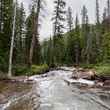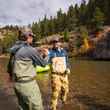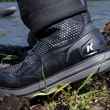My wife worries about me, and justifiably so, because remote trout waters and reliable cellular coverage rarely overlap. It’s both a blessing and a curse. I need to get away from the ringing phone, the sounds of cars, and the din of mankind, yet she needs to know that I’m safe. The needs, I’m afraid, are at odds.
At odds, that is, until now. I have my SPOT.

The plan was a bit loose for our ten-day tour of Montana and British Columbia; fly into Missoula, drive to Fernie for four days, then see where the rivers would take us. Keeping in touch with home from the western slopes and rolling Montana farmland would be problematic, at best. It’s not like I needed to share every detail, but rather to be able to show a direction and send an “all’s well.” I’d grab snippets of cellular bandwidth when they appeared, but most of the time a simple “sign of life” would suffice. My SPOT G3 did that, and more.
First, the basics. When activated, the small G3 device reads GPS satellites to determine its location. It then, via SPOT’s own satellite-based communications network, is able to send messages containing that location and pre-recorded greetings to whomever you choose and in a variety of ways.

My approach to keeping in touch was two-tiered. With SPOT’s new enhanced tracking enabled, I set an interval (I chose an hour, but it could be as little as two-and-a-half minutes) by which the device automatically send its location via both text message and email to my wife. These “pings” could also be plotted on a map (SPOT provides a convenient link in the emails) so that my progress could be shared. As we drove, I placed the G3 on the dashboard and as we hiked and fished, I clipped it to my vest or my jacket. No matter how remote, on the road or in the backcountry, my wife was able to keep up with my progress.
The second tier was a check-in message. At times when we stopped and settled into a fishing spot, or when I simply wished to say hello, I pressed the OK button and my pre-recorded “all is well” message, with location, was forwarded. More than just a sign of life, this was an “I’m here and I’m thinking of you” note, providing positive points back at home.

And this approach was just scratching the surface. Perhaps the most important feature of the SPOT G3 (and one that I hope never to need) is its ability to send an SOS in case of life-threatening situations. Linked to the GEOS International Emergency Response Coordination Center, it coordinates emergency responses with appropriate rescue organizations, worldwide, based on GPS location and personal info. Responders may include local police, highway patrol, the Coast Guard, your country's embassy or consulate, or other emergency response centers, including search and resue teams. No matter how remote, you can send up a flare if things go sideways.

The SPOT G3 also provides functions for engaging less critical assistance (roadside help, etc) and for sending a customized message, if needed. There is also a boatload of ways to share your locations and trip information with friends and family through SPOT’s interactive websites. There’s way too much fun to be had.
What Works
Tracking
The G3 knew where I was and communicated it without error. My wife could follow along, share in the adventure, and sleep better at night knowing I was safe and sound. It was also cool, upon my return, to retrace my steps through SPOT’s facilities.
Ease of Use
I turned it on each morning and forgot about it. When I wanted to specifically say that all was well, I simply pushed a button. It doesn’t get any easier.
Emergency Help
At the end of the day, it was reassuring to know that no matter how far in the sticks I was, I could push a button and engage the best emergency resources available.
What Doesn’t
Cost
At around $150, the G3 device itself is actually quite inexpensive, but to use the device you need SPOT’s Trace Services, which are almost as much as the device and recur annually. The basic package runs $9.99 a month (or $99.99 a year) and the Extreme Tracking Upgrade doubles that cost.
But you get what you pay for. I feel that for those who spend significant and risky time out of the range of cell service and who want the safety of the SOS feature as well as a solid connection to home, it’s well worth the expense.

Hot Spotting / Spot Burning
I was careful to mention that I carried this device to my guides and was more than willing to turn it off for the duration of our time in their care. I wanted to be sure that there was no perception of hot-spotting their personal honey-holes or recording specific locations for later use. Show some respect.
Escape
Sometimes you just want to get lost. With the SPOT, you can't. Seriously, there's no hiding. But then again, you can just turn it off.
Final Word
Being able to keep my wife informed and comfortable that I was alive and well despite the remoteness of my wanderings and uncertainty of my plans was priceless. And while the SPOT G3 was terrific for this extended trip, it will also be useful closer to home, cell service or no, allowing me to keep passive contact with friends and family or record breadcrumb trails during my solo wanderings.
Safety first.































Comments
Greg H replied on Permalink
Glad to see article on staying connected to world in remote settings. Especially important in the case that things go wrong. I worked alone in the Northern Maine Woods for a week at a time without any direct contact with humans (no phone, no cell service, no electricity) other than through my first generation SPOT. My wife was reassured each evening when she received my "OK" message via email. Important to note that this device should NOT preclude thorough preparation and care when in remote settings. My Boss emphasized to be careful to use the "(911) button on the SPOT only in life or death situations, otherwise I would be dead.
Mike Sepelak replied on Permalink
Thanks for that, Greg. It's good to get a professional's validation of the value of these devices. And you're absolutely right, there's NO replacement for careful and thorough preparation before stepping into the wilderness.
Stay safe in those North Woods!
Pages